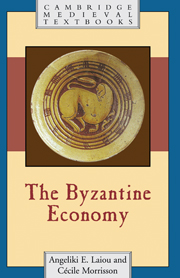Book contents
- Frontmatter
- Contents
- List of maps
- List of figures
- List of tables
- Acknowledgements
- List of abbreviations
- Introduction
- I Natural and human resources
- II The Late Antique economy and the shift to medieval structures (sixth–early eighth centuries)
- III Restructuring, recovery and controlled expansion (early eighth to tenth centuries)
- IV The age of accelerated growth (eleventh and twelfth centuries)
- V Small-state economics (from sometime in the thirteenth century to the fifteenth century)
- VI The Byzantine economy as exemplar; the Byzantine and the Western medieval economies
- Select bibliography
- Index
- Cambridge Medieval Textbooks
VI - The Byzantine economy as exemplar; the Byzantine and the Western medieval economies
Published online by Cambridge University Press: 05 June 2012
- Frontmatter
- Contents
- List of maps
- List of figures
- List of tables
- Acknowledgements
- List of abbreviations
- Introduction
- I Natural and human resources
- II The Late Antique economy and the shift to medieval structures (sixth–early eighth centuries)
- III Restructuring, recovery and controlled expansion (early eighth to tenth centuries)
- IV The age of accelerated growth (eleventh and twelfth centuries)
- V Small-state economics (from sometime in the thirteenth century to the fifteenth century)
- VI The Byzantine economy as exemplar; the Byzantine and the Western medieval economies
- Select bibliography
- Index
- Cambridge Medieval Textbooks
Summary
The Byzantine Economy as Exemplar
Throughout its long history the Byzantine Empire had a mixed and complex economy. The state played a role whose importance and weight varied depending on the development of production. But it was never the sole economic actor, and it never operated in an environment where economic processes were suspended. In other words, market forces always operated, with greater or lesser impact. In the period immediately following the seventh-century crisis, the presence of the state and its fiscality was paramount. Even then, however, basic economic laws functioned: thus, when, in 769, Constantine V ordered the payment of base taxes in cash, the markets were flooded with agricultural products whose price plummeted. Until some time in the tenth century, the state was the major motor force; it set in motion monetary circulation, for example, by collecting much of the added value of agricultural production and paying it out in public works and salaries to officials and soldiers. Once that had been done, though, money and merchandise circulated through market channels, although to a varying degree depending on the economic sector and area. Liberalization, in the sense of a greater autonomy of the markets, including the land market, began in stages in the course of the tenth century and continued through the eleventh and twelfth, while after that it took a particular form, since it occurred within the conditions created by an Italian-dominated Mediterranean economy.
- Type
- Chapter
- Information
- The Byzantine Economy , pp. 231 - 247Publisher: Cambridge University PressPrint publication year: 2007

